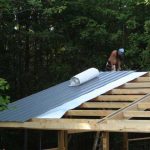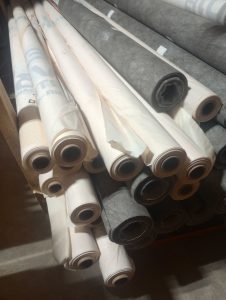Pole Barn Guru’s Ultimate Guide to Post Frame Building Insulation
When it comes to insulating any building (not just post frame ones – like barndominiums) there is a certain point of diminishing returns – one can spend so much they will never, in their lifetimes, recoup their investment.
Here my ultimate guide to post frame building insulation is based upon practicality and obtaining the best possible value for investment.
There are some basics applicable to any steel covered building:
Under any concrete slab on grade inside a building, place a well-sealed vapor barrier. Read about under slab vapor barriers here: https://www.hansenpolebuildings.com/2017/11/vapor-barriers-slabs-grades/.
Between roof framing and steel roofing – please do not assume condensation is not going to be a problem. At some point in time it will become one and if precautions are not taken regrets will happen. Condensation under roof steel is maybe number one of the issues I am asked to assist with.
 Least expensive financially, but does take some extra labor hours, especially if it is windy – a single air cell layer reflective radiant barrier. Six foot widths will install much quicker than four foot. Make sure to order with a six foot width NET COVERAGE and an adhesive tab along one edge with a pull strip. Without an adhesive tab all butt edges will require seam tape, not expensive, but adds lots of time. Do not waste your money on adding an extra approximate R 0.5 for double bubble (two layers of air cells).
Least expensive financially, but does take some extra labor hours, especially if it is windy – a single air cell layer reflective radiant barrier. Six foot widths will install much quicker than four foot. Make sure to order with a six foot width NET COVERAGE and an adhesive tab along one edge with a pull strip. Without an adhesive tab all butt edges will require seam tape, not expensive, but adds lots of time. Do not waste your money on adding an extra approximate R 0.5 for double bubble (two layers of air cells).
For a slightly great investment in materials, hours of labor can be saved by the use of an Integral Condensation Control bonded to roof steel. This would be my product choice. https://www.hansenpolebuildings.com/2017/03/integral-condensation-control/.
Next higher cost would be sheathing the roof with either OSB (Oriented Strand Board) or plywood on top of roof purlins. Roof purlins will need to be spaced appropriately so sheathing seams fall on purlins (16, 19-3/8 or 24 inches on center). Roof truss top chord live load must be increased to allow for greater dead loads. Either 30# felt (asphalt impregnated paper) or an Ice and Water Shield must be placed between sheathing and roof steel. Roof screws must still be placed to go into purlins, as thin sheathing is inadequate to adequately hold screws.
Bigger financial investment, but no extra labor involved is to have two inches of closed cell foam sprayed on the underside of roof steel. This will prevent condensation and is noise deadening. As a rough budgetary figure, plan upon spending roughly two dollars per square foot of roof surface.
Storage/Utility Buildings
If you ever believe anyone might ever have a future desire to climate control your building then provisions should be made for making it easiest to make future upgrades.
For now we will assume this building is totally cold storage. If it might ever (even in your wildest dreams) be heated and/or cooled include in your initial design, walls with a Weather Resistant Barrier (https://www.hansenpolebuildings.com/2016/01/determining-the-most-effective-building-weather-resistant-barrier-part-1/) between framing and siding.
Taking walls one step further would be ‘commercial’ bookshelf wall girts (https://www.hansenpolebuildings.com/2011/09/commercial-girts-what-are-they/).
In roof – have trusses designed to support a ceiling load, ideally of 10 pounds per square foot (read about ceiling loaded trusses here: https://www.hansenpolebuildings.com/2016/03/ceiling-loaded-trusses/).
Trusses should also be designed with raised heels to provide full depth of future attic insulation above walls (https://www.hansenpolebuildings.com/2012/07/raised-heel-trusses/).
Make provision for attic ventilation, by having an air intake along sidewalls using enclosed ventilated soffits and exhaust with a vented ridge.
Any overhead doors should be ordered insulated – just a good choice in general as, besides offering a minimal thermal resistance, they are stiffer against the wind.
Equine Only Use
Same as storage/utility however ventilation is essential (and often overlooked). (Read more on stall barns here: https://www.hansenpolebuildings.com/2012/08/stall-barn/)
Garage/Workshop/Man Cave/She Shed/House/Shouse/Barndominium
Many previous recommendations are going to be repeated here. Ultimately it is going to depend upon willingness to include higher R values in initial budget, rather than having increased utility bills forever.
Start with a Frost-Protected Shallow Foundation – post frame version (https://www.hansenpolebuildings.com/2016/11/frost-protected-shallow-foundations/) with sand on the inside rather than a thickened slab. This makes for an excellent and affordable design solution.
For walls, we will again work from generally ascending price and R values.
On low end would be having installed a weather resistant barrier beneath wall steel, in conjunction with commercial bookshelf wall girts. Fill insulation cavity with unfaced batt insulation and cover inside face of wall with a well-sealed six ml clear visqueen vapor barrier. As an alternative to fiberglass would be mineral wool insulation as it is not affected by moisture (https://www.hansenpolebuildings.com/2013/03/roxul-insulation/). This method can be entirely done D-I-Y.
 I have personally used BIBs (https://www.hansenpolebuildings.com/2011/11/bibs/) in several buildings, including my current barndominium home. It does require a certified installer.
I have personally used BIBs (https://www.hansenpolebuildings.com/2011/11/bibs/) in several buildings, including my current barndominium home. It does require a certified installer.
A Weather Resistant Barrier can be eliminated by the use of a ‘flash coat’ of two inches of closed cell spray foam against the inside of wall steel. Balance of wall cavity can be filled with batt insulation. (https://www.hansenpolebuildings.com/2016/07/advantages-spray-foam-over-batt-insulation/).
For added R value and a complete thermal break, add two inch rigid closed cell foam boards to inside of framing. To maintain thermal break integrity, glue foam boards to inside of framing and properly seal all seams. Gypsum wallboard can be glued to the face of foam boards.
After ceiling has been installed, have insulation blown into dead attic space, following Energy Star™ guidelines (usually R-45 to R-60).









Hello, I just had a 40 by 40 pole barn built. I’m getting ready for insulation but not sure when they vapor barriers come into play. I have a ridge vent running along the whole top of the building and wonder how much of the heat will be going out right at the top. The roof is sheeted with plywood below the metal roofing. After insulation do you recommend putting a vapor barrier over the top of it?
With the guess you will adding insulation at the ceiling line, you should not have a vapor barrier either above or below the attic insulation. In order for the ridge vent to work as designed, you want to make sure you do not block the air intake from the sidewall soffit vents.
I live in SE Pennsylvania and want to build a 30 by 40’ pole garage. What do I look for in a contractor and the materials he wants to use. Is there a single source of information. Thanks for your time.
IMHO – no matter what demand a fully engineered building, specific to your dimensions and features on your property. Your best source of post frame (pole) building information is this website – utilize the search feature in the upper right hand corner.
I’m wondering about gluing 2in rigid foam board to the inside face of the bookshelf girts. I’d like to use a WRB then fill cavities with mineral wool unfaced batts. Then glue foam boards to the edge faces of the girts then drywall on top of those. Will the foam boards act as the vapor barrier in this case and thus a plastic sheeting vapor barrier will not be needed? If it is still needed how do you glue the boards or drywall to the plastic sheeting? If it’s not required then do you just glue up the foam boards then glue the drywall to the foam boards or do you also need to screw then in with 3in or longer drywall screws? Next question is for electrical outlets. How do you mount them if you have the 2in boards to get through to mount them to the girts? And if the girts are sideways how do you mount the boxes vertically? 2×4 blocking placed everywhere you need an outlet extended 2in past the girts to the faces of the foam board? Thanks for your help!
As long as you seal the seams of your foam boards, they will act as your vapor barrier. You can glue only. Use ReWork boxes and mount vertically anywhere.
Existing post frame building in upstate South Carolina . Turning into man cave. Want to retain vaulted look. Concerned about roof insulation:
– Galvalume metal roof panels
– Rafters 2 x 6 spaced 24” on center
– 1 x 4 purlins
– Added vented soffits and ridge vent
Insulation contractor wants to install R-19 vinyl backed fiberglass. I’m concerned about air flow from soffits to ridge vent. Will his idea work? Is there a better option that won’t break the bank?
Thanks!
How are you currently controlling condensation?